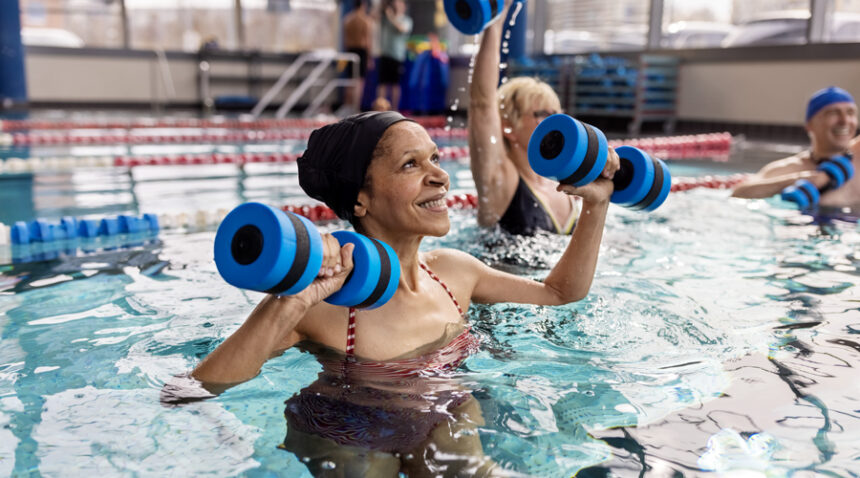Regular exercise provides many health benefits, from reduced risk of chronic conditions to improved mood, sleep and focus. Walking is often recommended as an easy way to exercise, but for people with limited mobility in their lower bodies, it’s not a viable option.
Mobility impairments, which can result from age, injury or a chronic disease, shouldn’t stop you from exercising; in fact, a sedentary lifestyle can cause conditions that will make mobility issues more difficult, such as obesity, heart disease and diabetes.
“There are a lot of mental barriers and anxiety,” says Mary Hale, a certified personal trainer with UNC Wellness Centers. “A lot of people with mobility issues have tried to work out on their own and failed. They worry they’re being looked at. But you can do it! You have the ability to be strong and active and find what works for your body right now.”
Hale shares some activities that people with limited mobility can pursue to achieve their exercise goals.
Exercise Options for Limited Mobility
Water workouts: Swimming, water aerobics, and water walking or jogging are beneficial for people with mobility issues.
“If you’re in water up to your chest, 80 percent of your body weight is absorbed,” Hale says. “That means you can jog without pain or impact on your joints.”
If you’re visiting a facility with a pool, check for a ramp or a hydraulic lift chair, or ask if there is a water wheelchair available. These accommodations will make it easier to get in and out of the pool.
Recumbent bikes or ellipticals: Recumbent machines, found in most gyms, are a great way to incorporate aerobic activity and move your legs without putting impact on your joints or risking a fall.
Recumbent bikes and recumbent ellipticals allow you to exercise from a more reclined position with your legs in front of you. Some have arm levers so you can push with your hands to help move your legs. These machines are typically easier to get on and off because they are lower to the ground than an upright bike or stepper.
Strength training: “Strength training is so important for anybody with mobility issues,” Hale says, noting that strength workouts can increase mobility.
“Don’t start with free weights,” she says. “They require a large amount of stability and control. Weight machines are more predictable, and they can help someone build up their base strength.”
A personal trainer can help you design a strength program suited to your mobility needs and see that you are exercising safely.
Pilates and yoga: Pilates and yoga can strengthen muscles and improve stabilization, but people with limited mobility may have to search for the right class for their needs.
“A lot of yoga and Pilates studios cater to the young and mobile, but a medical fitness center will offer classes that are more appropriate for limited mobility, like chair yoga or a session on a Pilates reformer, which is a piece of specialized equipment that combines strength and stability into your workout,” Hale says.
Chair workouts: If working out in a gym isn’t in the budget, aerobics, core exercises and yoga can all be done from a chair. Hale recommends chair workouts available on YouTube; look for the host’s credentials, which will indicate if the person is a professional and therefore concerned about the soundness of the exercises.
“A chair provides stability, so these workouts are appropriate for someone who is a beginner to exercise,” she says. “You don’t have to worry about losing balance or falling. Once you feel stronger and more confident, you might need the chair less.”
Getting Started with Limited-Mobility Exercise
It’s important for people with limited mobility to speak with their doctor before beginning exercise. If possible, Hale also recommends that people work with a personal trainer who can help design a program that’s best suited to specific mobility issues.
“You should ask a prospective trainer about their background and certifications and if they have experience in your specific mobility issue,” Hale says. “At commercial gyms, the trainers may have less experience with diverse backgrounds, but at a medical fitness center, you’re more likely to find someone with a degree in exercise science and an understanding of working with people with limited mobility.”
Doctors and trainers can also provide guidance on how often and how long you should exercise. If they advise starting slow, they can also explain when you can increase the difficulty or frequency of your workouts and what amount of soreness is appropriate after a workout.
Joining a gym or fitness center can be a good option for people with limited mobility, but Hale recommends taking a tour and asking questions before finalizing an agreement.
“If you’re considering joining a fitness center, make sure they have a plan for medical emergencies or for someone falling,” she says. “Some gyms pack a lot of equipment into a small space, so make sure there’s room for assistive devices like wheelchairs or walkers. Ask about whether it’s OK to bring in outside equipment, such as a grip assist for lifting, or an outside trainer who specializes in mobility issues. A supportive facility and knowledgeable staff can be a huge help.”
Talk to your doctor about your mobility issues before beginning a new exercise program. Need a doctor? Find one near you.

